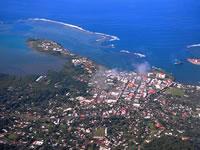Samoa: Rehabilitation and sustainable management of Apia Catchment
Aims: To rehabilitate and improve the quality and quantity of the water resources of the Apia Catchment
Activities: Review and formulation of catchment policy and management plan to facilitate effective water conservation, allocation and service provision; Conservation and rehabilitation of degraded areas to reduce water pollution; Land use monitoring; Ecotourism; Capacity building and public awareness for watershed management
"3(A) INDICATOR#1: INCREASE IN LAND PROTECTED AND/OR REHABILITATED OVER
CATCHMENT
The target of the project was to increase the amount of land protected in Apia Catchment. So far around 1500 hectares of upland catchment areas have been proposed for protection, and 15 hectares of the catchment have been identified as priority for rehabilitation."
"2. RESULTS: PROCESS
The IWRM Stakeholders (CCC) consultation process developed by the project is bringing great benefits for water resource and catchment management with continuous attendance from many stakeholders, each contributing feedback on and suggestions for the project activities. Participation of stakeholders in planning and monitoring has increased ownership over IWRM concepts and activities. An important result of this was agreement on the Watershed Safety plan for Fuluasou, and actions for dealing with the many issues around its intake and supply have been identified and prioritized for
implementation. This is significant as Fuluasou Treatment Plan supplies 70,000 people and suffers from many problems such as overcapacity, shortage of chlorine, pump failure, and high NRW rates.
Watershed Management Plans (WWPs) for Loimata o Apaula, Gasegase, and Fuluasou catchments (3 of the 4 catchments in the Apia Catchment) are in final draft stage and ready for management approval. The WMPs gives authority to the Water Resources Division to enforce specified directives and prosecute any illegal activities. These efforts have been supported by awareness and education activities on World Water Day annually, and have been successful in raising the profile and visibility of GEF Pacific IWRM Samoa. The Watershed Conservation Policy lead by IWRM project where the top 600m of the country land will be excluded from any developments has brought some positive feedback from some sectors especially the Water Authority who are struggling to accommodate for the water demands of people living on the highland
2(A) INDICATOR#1: NATIONAL STRATEGY IN PLACE
At the time of project start-up there was no national strategy for IWRM or water resource management in Samoa. The target of the project was to a have a sector wide strategy for water by mid 2012. This Sector Wide Approach Plan for Samoa is an IWRM focused plan being implemented under the Samoa Water Coordinating Unit and is widely known as our national water sector strategy. The water crisis of the 2011 drought has raised awareness of water issues at the highest political levels.
2(B) INDICATOR#2: APIA WATER SAFETY PLAN (URBAN)
The target for the project was to have a water safety plan for Apia urban area developed, endorsed by Cabinet, and under implementation. At the start of the project there was no plan and a lot of uncertainty of water safety issues, especially associated with the overloaded Fuluasou Treatment Plant. The Water Safety Plan has been developed through IWRM, endorsed by cabinet, and actions for the intake and supply side have been identified, costed and prioritized.
2(C) INDICATOR#3: LEGISLATION FOR WATER RESOURCE MANAGEMENT
At the start of the project Samoa had legislation and regulations relating to surface water quality. The target of the project was to have legislation for water resource management enacted as part of Watershed Management Plans. In addition to endorsement of the Fuluasou Treatment Plant by Cabinet, legislative needs to implement the 3 Apia Watershed Management Plans have been identified. The Watershed Conservation Policy has been developed to provide guidance to drafting of legislation.
2(D) INDICATOR#4: PROPORTION OF COMMUNITY ENGAGED IN WATER RELATED ISSUES
The target of the project was to establish 30% increase in active engagement activities. At the time of project start-up almost all community engaged was passive. IWRM has focused on community groups participation in clean-ups and forest rehabilitation. On World Water Day 2011, a river clean up event on the Fuluasou River was a successful day with many community members attending. It also identified some areas being used for dumping rubbish into the Fuluasou River. The project has subsequently assisted the community by placing rubbish stands around the area for their rubbish. "
| Photo | |
|---|---|
 |
|
| Data | |
|---|---|
| Year | 2012 |
| Reporting date | 14-Mar |
| Related sites |
|---|
|
Ridge to reef: protecting water quality from source to sea in the Federated States of Micronesia
Improved catchment management
Environmental and socio-economic protection in Fiji: Integrated flood risk management in the Nadi River Basin (site 2)
Improved catchment management
Tonga: Improvement and Sustainable Management of Neiafu; Vava’u’s Groundwater Resource
Pollution Reduction to Aquifers: N
Integrated Sustainable Wastewater Management (Ecosan) for Tuvalu
Municipal Wastewater Pollution: N
Integrated Sustainable Wastewater Management (Ecosan) for Tuvalu (site 2)
Water Use Efficiency
Integrated Sustainable Wastewater Management (Ecosan) for Tuvalu (site 3)
Water Use Efficiency
Vanuatu: Sustainable Management of Sarakata Watershed (site 2)
Improved catchment management |

























